
After decades of repeated reinvention, the silicon transistor is starting to show its age, and the industry is hunting for alternatives. One option involves a new way of manipulating the properties of a material that the computer industry already uses. If it works, it would lead to computer processors that are not only more energy-efficient but also capable of both computation and memory storage at once.
With some tinkering, researchers found that they could make ferroelectric materials—widely used to store data using an electrical charge—switch rapidly between four different states. A transistor made of the material could use those states to represent more than the 1s and 0s that are the basis of today’s digital logic; it could hold each state without the need for an external power source; and it might be able to process information as well as store it.
via Technology Review
Image: Growing ferroelectric materials in a herringbone pattern, as shown in this colorized image,
may make them suitable for use as transistors.





